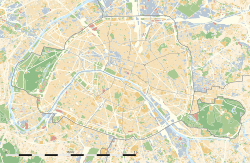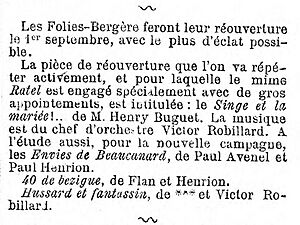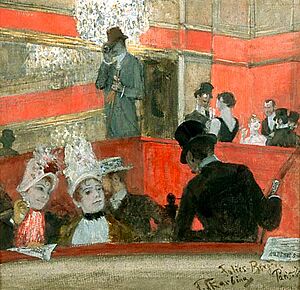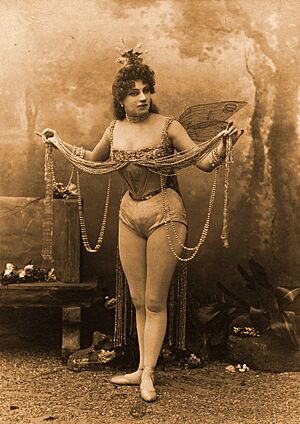Folies Bergère facts for kids
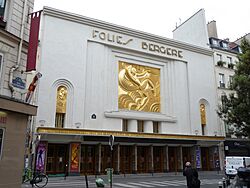
Exterior view in 2013, after renovations
|
|
| Address | 32 Rue Richer Paris France |
|---|---|
| Coordinates | 48°52′27″N 2°20′42″E / 48.8742°N 2.3449°E |
| Designation | Cabaret music hall |
| Construction | |
| Opened | 2 May 1869 |
| Architect | Plumeret |
The Folies Bergère is a very famous cabaret music hall in Paris, France. It is located at 32 Rue Richer in the 9th area of Paris. The building was first designed as an opera house by an architect named Plumeret.
It first opened on May 2, 1869, and was called the Folies Trévise. At that time, it offered fun shows like short operas, funny plays with music, popular songs, and even gymnastics. On September 13, 1872, its name changed to Folies Bergère. This new name came from a nearby street called Rue Bergère. The Folies Bergère became extremely popular from the 1890s, during a time known as the Belle Époque, all the way through the 1920s.
The shows at the Folies Bergère were known for their amazing costumes, detailed stage designs, and special effects. Famous performers like Josephine Baker made a big splash there. In 1926, Josephine Baker, an American singer and dancer, became very famous at the Folies Bergère. She performed in a unique costume that included jewelry and a skirt made of rubber bananas.
Today, the Folies Bergère is still open and is an important symbol of French and Parisian culture. You can reach it by taking the Paris Metro to the Cadet or Grands Boulevards stations.
Contents
History of the Folies Bergère
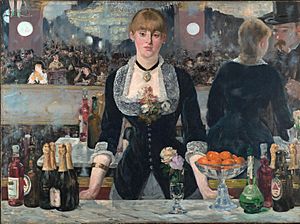
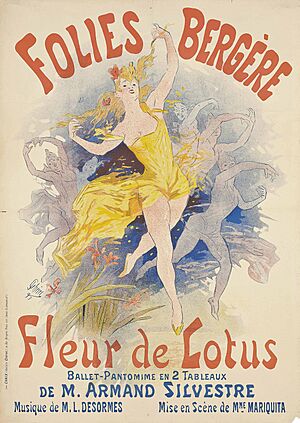
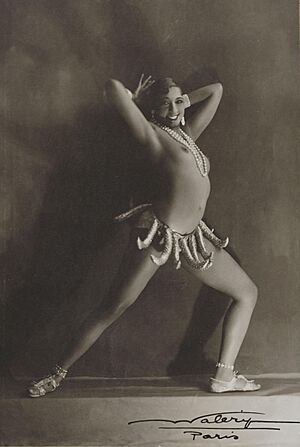
The Folies Bergère opened on May 2, 1869, at 32 Rue Richer in Paris. It was first called the Folies Trévise. The building was designed by an architect named Plumeret, who was inspired by the Alhambra music hall in London.
The word "folies" in the name refers to places that were built for entertainment and fun. The original name, Folies Trévise, came from a street near the stage door. However, a duke named Duc de Trévise did not like the theater using his family's name.
So, on September 13, 1872, the theater changed its name to Folies Bergère. This new name came from a nearby street called Rue Bergère. "Bergère" means "shepherdess" in French.
In 1882, the famous artist Édouard Manet painted his well-known artwork called A Bar at the Folies-Bergère. This painting shows a bar worker at the Folies Bergère.
New Kinds of Shows
In 1886, a person named Édouard Marchand came up with a new type of show for the Folies Bergère. This was the start of the "music-hall revue" style. These shows focused a lot on women performers. On November 30, 1886, the Folies Bergère put on its first revue-style show called Place au jeûne !. It featured performers like Alice Berthier and chorus girls in dazzling costumes. This show was a huge success.
In the early 1890s, an American dancer named Loie Fuller became a star at the Folies Bergère. In 1902, Marchand had to leave because of illness after 16 years of leading the shows.
The Era of Paul Derval
In 1918, Paul Derval (1880–1966) took over and made his mark on the revue shows. His shows were known for their incredibly fancy costumes, amazing stage designs, and special effects. Derval's shows often featured many women performers, which became a special part of the Folies Bergère's identity. During his 48 years there, he helped many French stars become famous, including Maurice Chevalier, Mistinguett, Josephine Baker, and Fernandel.
In 1926, Josephine Baker, an American singer and dancer, created a huge buzz at the Folies Bergère. She performed in a new show called La Folie du Jour. In one part, she danced wearing a unique costume that included a skirt made of artificial bananas. She also performed in another show called Un Vent De Folie in 1927. The Folies Bergère shows were very popular and often featured elaborate costumes. They also celebrated different cultures, which was very interesting to people in Paris during the 1920s.
In 1926, the outside of the theater was completely redesigned by the artist Maurice Pico. The new look was in the Art Deco style, which was very popular for buildings in Paris at that time.
In 1936, Josephine Baker returned from New York City, and Derval signed her to lead a new show called En Super Folies.
Michel Gyarmathy, from Hungary, designed the poster for En Super Folies. He worked at the Folies Bergère for 56 years!
Paul Derval passed away on May 20, 1966, at 86 years old. He had been in charge of the famous music hall for a very long time. His wife, Antonia Derval, took over with the help of Michel Gyarmathy. In August 1974, Antonia Derval handed over the business to Hélène Martini, who had actually been a showgirl in the revues 25 years earlier.
Since 2006, the Folies Bergère has also put on musical productions with Stage Entertainment. Some of these include Cabaret (from 2006 to 2008) and Zorro (from 2009 to 2010).
Similar Entertainment Venues
The Folies Bergère inspired many other similar shows around the world. For example, the Ziegfeld Follies in the United States and the Teatro Follies in Mexico were created because of it. There was also a long-running show called The Las Vegas Folies Bergere at the Tropicana Resort & Casino in Las Vegas. It opened in 1959 and closed in March 2009, after almost 50 years of performances.
In the 1930s and 1940s, a show producer named Clifford C. Fischer put on several Folies Bergère-style shows in the United States. These included the Folies Bergère of 1939 in New York and the Folies Bergère of 1944 in San Francisco.
A more recent example is Faceboyz Folliez, a monthly variety show in New York City.
See also
 In Spanish: Folies Bergère para niños
In Spanish: Folies Bergère para niños
- Showgirl
- Casino de Paris
- Moulin Rouge


